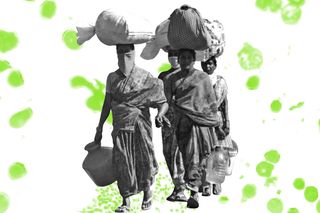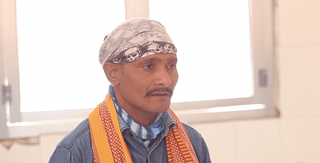
A Public Health Crisis Looms at the Intersection of Migration and Tropical Diseases
Lacking awareness and access to urban support networks, migrants from rural areas find it difficult to seek treatment for diseases like filaria.

This is the third report in a four-part series that explores the social determinants of living with and in proximity to lymphatic filariasis, a neglected tropical disease.
In the one year that Gyan Prakash, 35, has lived with lymphatic filariasis (filaria), he’s traveled from Delhi to Rae Bareli, U.P., four times for treatment. “I come here every three months for treatment because my family is here and they told me to get checked here when [I] first found swelling,” he says.
A fruit and vegetable vendor in Delhi, Prakash lives alone and works in a crowded market teeming with stagnant puddles and mosquitoes. His only opportunity to receive medication, care, and comfort is at home in Rae Bareli, where his wife and children stay. He attempted to find help in Delhi but didn’t know the city well enough to find it.
Travel back and forth between the locales has become an essential — and expensive — part of his life. A train ticket from Rae Bareli to Delhi costs up to Rs. 200 in the cheapest Second Seater Class Section, and a bus ticket costs half of that. A travel budget of Rs. 1000-2000 a year, needed to access medication, becomes a severe strain while also trying to pay for rent, food, and other living expenses with a daily-wage income. Travel is also tinged with discomfort, as the swollen legs and lesions that accompany filaria make walking difficult.

Gyan Prakash. Photographs by Sunny Singh
Prakash’s story intertwines two conditions that have become almost synonymous with neglect: tropical disease and migration. Migrants, new to a city and short of means, do not know the location to which they have shifted and do not have access to safe living conditions and urban healthcare systems that can aid the prevention and management of filaria. In contradiction to popular assumption, some migrants choose to travel back home to seek help from familiar, rural healthcare systems.
Related on The Swaddle:
When Climate Change Leads to Fear and Migration, Women Bear the Brunt
Here, it is key to understand what kind of migrants face this particular struggle. “It is not only the white-collar workers or the section of citizens who migrate for higher education, training and then move overseas for employment or high-end jobs,” says Rinju Rasaily, Ph.D., an assistant professor of sociology at Ambedkar University, Delhi. “It is also the insignificant bulk of the population who, given the rising needs of a neo-liberal world, undoubtedly triggered by poverty and despair, seek to migrate out of their villages and small towns for jobs, jobs that are precarious and thus uncertain; taking the risks of living in a city space for a better future.”
According to India’s 2011 Census, more than 139 million internal migrants move around India, within and between states. Large, urban cities like Delhi and Mumbai attract most migrants, sharing a combined migrant population of 9.9 million between them.
Working-class migrants in big cities live and travel in highly clustered conditions close to open gutters — all of which lead to a higher risk of exposure to filarial worm-carrying mosquitoes. This clustering is not a new phenomenon. “As Indian cities grew, they attracted large numbers of migrants, especially after the 1940s, when the population in cities, according to the census, grew exponentially. Often poorer migrants settled in already populated areas of the city, creating pressures on existing drainage systems,” says Aditya Ramesh, Ph.D., who researches water, infrastructures, and ecologies at the University of Manchester. “The colonial government, when they started creating drainage systems from the 1850s, paid little attention to regions where the urban poor lived. They created drainage systems largely to protect British cantonments and to try and keep sewage out of these areas. Naalas (open gutters) therefore were the only affordable way in which dense urban settlements could dispose of waste. Considering the pressures on them, it is no surprise that as infrastructural systems, they are stressed.”
“Bear in mind as well, that the regions around the naalas (gutters) were often government or common land, and the only spaces where migrants could find a space to build a shanty,” Ramesh adds.
A significant number of migrants originate from Bihar and Uttar Pradesh, coincidentally two states that share a significant burden of filaria cases in India, alongside Jharkhand, West Bengal, Chhattisgarh, Maharashtra, Madhya Pradesh, and Odisha.
Though working-class migrants face a higher risk of water-borne tropical diseases like filaria, they do not receive close healthcare attention. “The vulnerability of migrants is unimaginable, given their working and living conditions. Data on health expenditure clearly state that the out-of-pocket [healthcare] expenditure is exorbitant in India. There is undoubtedly an enormous burden on government hospitals, dispensaries, health care centers, and mohalla clinics in Delhi, while the private health care services cater to the massive Indian middle class,” Rasaily says. She adds that only a negligible percentage of urban migrants have health insurance, making it harder to access subsidized healthcare.
Work conditions may also force migrants to make choices under duress, choices that put their health at risk. Employment often involves long hours that lead to a deprioritization of seeking help. This means chronic conditions like filaria get further aggravated. “There is also a large reliance of this section of our population on the un-registered medical practitioners who usually administer stronger dosage of medication for immediate relief,” Rasaily says. Though immediate relief allows migrants to function, it eventually takes a serious toll on long-term health.
Related on The Swaddle:
SC Directs States To Look Into the Condition of Migrant Workers’ Children
This negotiation between work and health is not uncommon for individuals with filaria, as the disease is incurable and causes swollen limbs, flashes of pain, and reduced mobility. For working-class migrants, the drop in productivity is devastating, especially since most are paid by the day. Researchers have documented severe drops in filaria patients’ ability to perform domestic and economic labor in both Odisha and Tamil Nadu, with several cases leading to total disability.
The neglect of migrant workers with filariasis is as much a labor issue as it is a public health issue. Though trade unions have fought for decent working conditions for migrants in the past and helped create several equitable labor laws, there was no uniform health and safety law for working-class individuals; however, under the present regime labor laws have been amalgamated into four labor codes. One of them is the Occupational Health and Safety Code that clandestinely transfers the responsibility of workers’ welfare from the employer to the state as earlier envisaged in the sector-specific laws such as the Plantation Labour Act 1951, the Cine Workers Welfare Fund Act 1981, and so on.
“As health care involves huge expenditure to the government, it has remained a central reason for the non-prioritization for the migrant population as well,” Rasaily adds. “In terms of intervention that could help migrant workers, I feel that a revisit of the Inter-State Migrant Workmen Act (Regulation of Employment and Conditions of Service), 1979, is important. It is also crucial that there should be a budgetary enhancement towards all the state departments of labor so that labor laws could be enforced, data banks could be created, and timely interventions could be made — for example, at inter-state borders, bus stands, railway stations, et cetera. And importantly, there should be inter-departmental sync, such as [between] Regional Labour Institutes, DGFASLI [Directorate General Factory Advice Services and Labor Institutes] that operate under the same ministry, i.e Labour and Employment, GOI.”
While rural areas are small and close-knit, urban areas are vast and lonely. Rural migrants like Prakash face a significant loss in the absence of community support. Village kinship ties are important means to find employment and support in cities. In rural areas, there is also more familiarity and comfort in relying on support systems, like borrowing from friends and relatives, which is often not an option in an alien urban environment. As Prakash said in the beginning, he didn’t just return to Rae Bareli because he couldn’t find help in the city, he also returned because that is where his home and community are.
Aditi Murti is a culture writer at The Swaddle. Previously, she worked as a freelance journalist focused on gender and cities. Find her on social media @aditimurti.
Related


The Second Wave: A Janitor Who Is Overworked and Underpaid Says “No One Asks If We Are Struggling”
